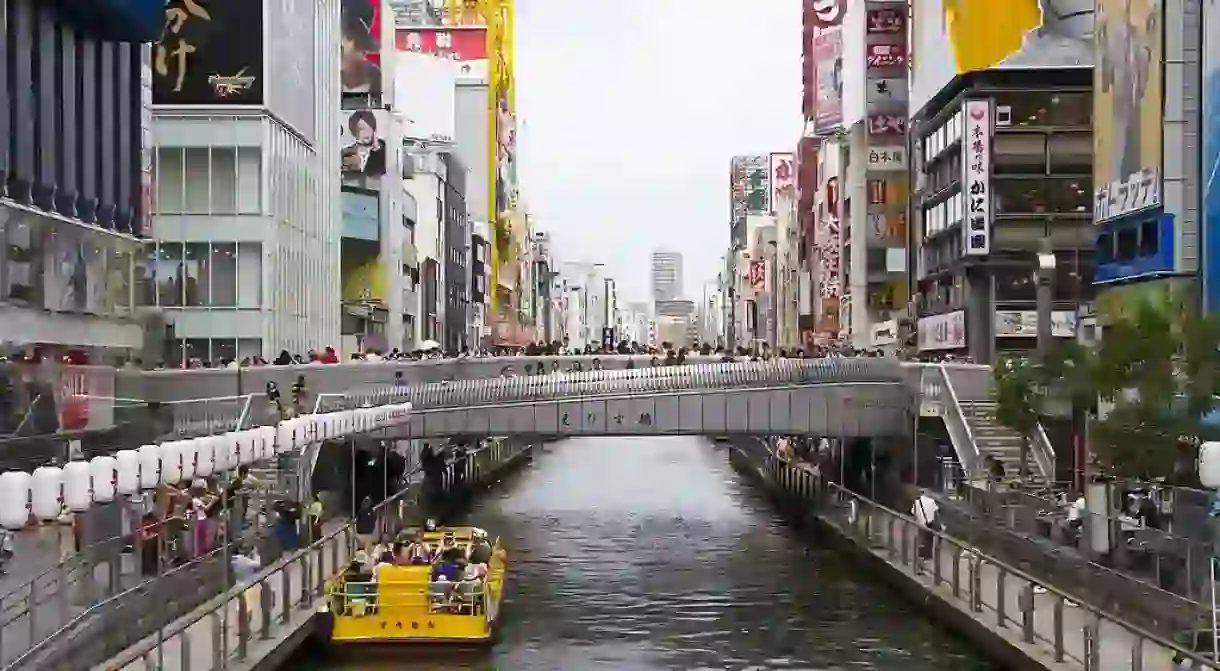How to Spend 5 Days in Osaka - 5 Day Itinerary

Osaka possesses a unique eccentric and energetic vibe. This is one of those cities that has everything – internationally renowned food, breathtaking historical sites, diverse culture, and a plethora of shopping options. There’s so much to do in Osaka that any traveler should spend at least five days in the city. Here, we show you how.
Day 1 – Eat and shop ’til you drop in Minami
Osaka has two main downtown hubs in the north and south. Start your trip off with a bang in the latter, Dotonbori. This beloved entertainment hub, historically filled with markets and theaters, has retained much of its original charm, but is also filled with trendy clubs, international brand shops, and towering glowing advertisements reminiscent of Times Square.

Pose on Ebisu Bridge with the famous Glico Man sign. Stroll along the Tonbori River Walk, located alongside the area’s namesake canal. Shop at Don Quixote, an eclectic one-stop-shop offering tax-free shopping for tourists and complete with a Ferris wheel.
Dotonbori Street is where to find the eats Osaka is known for – takoyaki, okonomiyaki, and kushikatsu. Shinsaibashisuji, one of Osaka’s longest covered shopping streets, is packed with shops, restaurants, pachinko parlors, and karaoke booths. There’s also a lot to be found in the side streets that branch off from the main drag.

Take a break in the backstreets at Hozenji, a moss-covered temple that somehow remains quiet and peaceful in the middle of downtown. Then stroll down adjacent Hozenji Yokocho, a cobbled, atmospheric street lined with local restaurants and bars.
Next, explore Nipponbashi, also known as Den Den Town, where game and anime nerds love to hang out and you can find great deals on electronics.
At night, take in the bright lights of Dotonbori, go clubbing in Shinsaibashi, or bar hop in Amerikamura.
Day 2 – Step into the city’s storied past
Make a pilgrimage to Sumiyoshi Taisha, a gorgeous and enormous shrine in south Osaka. The shrine is peaceful, especially in the early morning, when you can explore uninterrupted.

Next, visit Osaka Castle. The historic structure is surrounded by an enormous park, so take your time frolicking around the grounds before taking in the impressive moat, turrets, and castle walls, all of which have survived for centuries. The castle itself has been destroyed many times, but was rebuilt as a museum to resemble its former glory. Food trucks are always parked outside, so try taiyaki or some matcha ice cream.

Day 3 – Wander the stylish streets of Umeda
Umeda is the northern hub of Osaka. Centered around Osaka/Umeda Station, an enormous train terminal, this is a great place to eat and shop. Many malls are built into the station itself, like Lucua, Grand Front, and Osaka Station City.

For a more relaxed shopping experience, head to Chayamachi, a hip and fashionable district, and visit hobby store Loft and bookshops Maruzen and Junkudo.
Nearby is artsy Nakazakicho, an area filled with independent galleries and coffee shops, and the Umeda Sky Building, from where you can see sweeping views of the city, as well as enjoy an Edo-era themed shopping and dining experience on the basement level.
Day 4 – See a little bit of everything in Osaka’s quirky eastside
Spend this day on the east side of the city, visiting well-known sites like Abeno Harukas, the nation’s tallest building, and Shitennoji, Japan’s oldest Buddhist temple. This area, known as Tennoji, is also home to a zoo and yet more shopping.

Afterwards, head to Shinsekai (“New World”) an old, bustling neighborhood, home to local favorites like Tsutenkaku Tower and Spa World. Here, you can find great local food and enjoy the vibrant, kitsch atmosphere for which the city is known.

Day 5 – Go back in time to explore Osaka’s merchant roots
Spend your last day in Tenma, an eclectic area that offers a glimpse into a more authentic and traditional side of Osaka.
Walk down Tenjinbashisuji, Japan’s longest shotengai (covered shopping street), and get a feel for Osaka’s roots as a merchant city. Visit the Osaka Museum of Housing and Living, Tenma Garden, and more while you’re there.
Then head to Osaka Tenmangu, the city’s most famous and important shrine, and home of the annual Tenjin Festival (July 24 and 25).

Finally, wander the backstreets around JR Tenma Station, where there are countless tiny restaurants and bars. Mingle with local salarymen and women, and practice your Osaka dialect while you drink and recount your time in Japan’s second city.
If you’ve still got time to kill after all that, there are lots of things to do in Osaka to help you experience one of Japan’s best cities.













